
iMPOWER
UX Design / Product Design
Individual Project
Sponsor MAYLOVE(China)
11.2018 - 01.2020
I empathised on sexual assault survivors and designed iMPOWER that intervenes in the current post-assault experience to protect and empower survivors by facilitating full recovery in China and beyond.
Problem Statement
On average, there are 342,500 victims of rape and sexual assault each year in China. And 90% of assaults are committed by repeat perpetrators.
However, because China doesn’t have the necessary infrastructure and service to handle sexual assault cases, besides lack of sexual education, few survivor is able to access appropriate emotional and medical treatment.
In the meantime, because of the culture, which is rampant with victim-blaming and doubt surrounding accounts, sexual assault isn’t just an issue of physical violation, but leaves victims feeling isolated and powerless with fear of unknown.

Project Goals
- Reduce the fear of unknown and help survivors to gain a sense of control back.
- Reduce re-traumatisation and re-victimisation during the survivor’s mental-emotional healing process.
- Build a platform for bridging new survivors, super-healed survivors and professional trained volunteer together, as well as medical organisation.
- Change the stigma on sexual assaulted survivors.
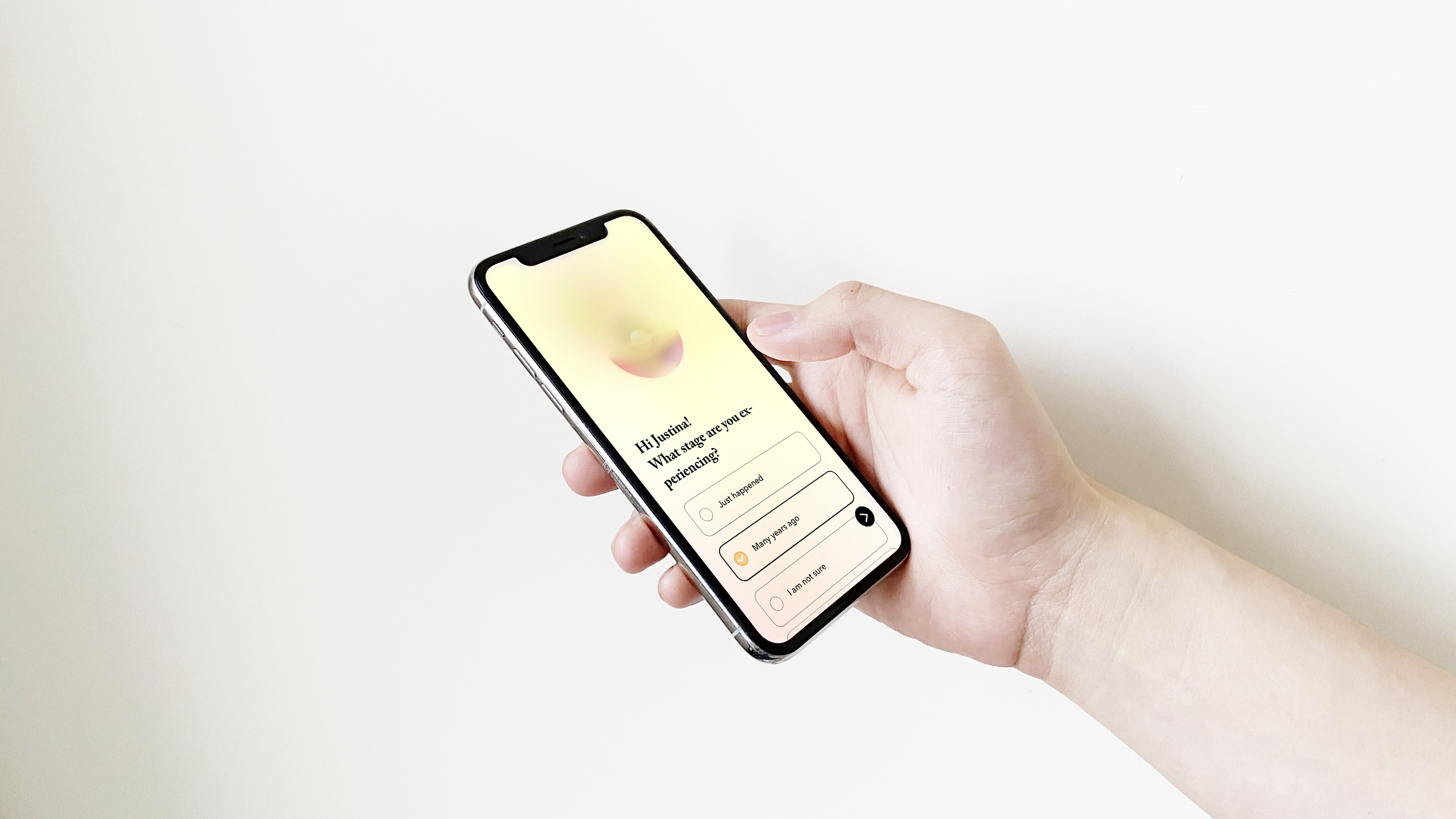
Research Methods
- Stakeholder Interview
- Emotional Diary
- Prototype testing
- Field Research
- Information Architecture
- Experience Journey
- Persona
- Analogous Scenario
One of the many challenges of this project was how to define the design scope in this complex question involving legal, ethics and society. So I broke the experience into two pillars and did specific research for each part.
On legal issues, I interviewed with a chief procurator, an attorney and a police investigator for mapping out the user journey map and understanding the current official situation. On the user side, I reached out to a doctor, a nurse, a NGO volunteer and a psychologist to gain insights on survivors’ needs, motivations and frustrations to help shape the product solution, in terms of I was not able to interview users - survivors - directly because of ethical issue. In the meantime, I did field research in hospitals and analogous public places.
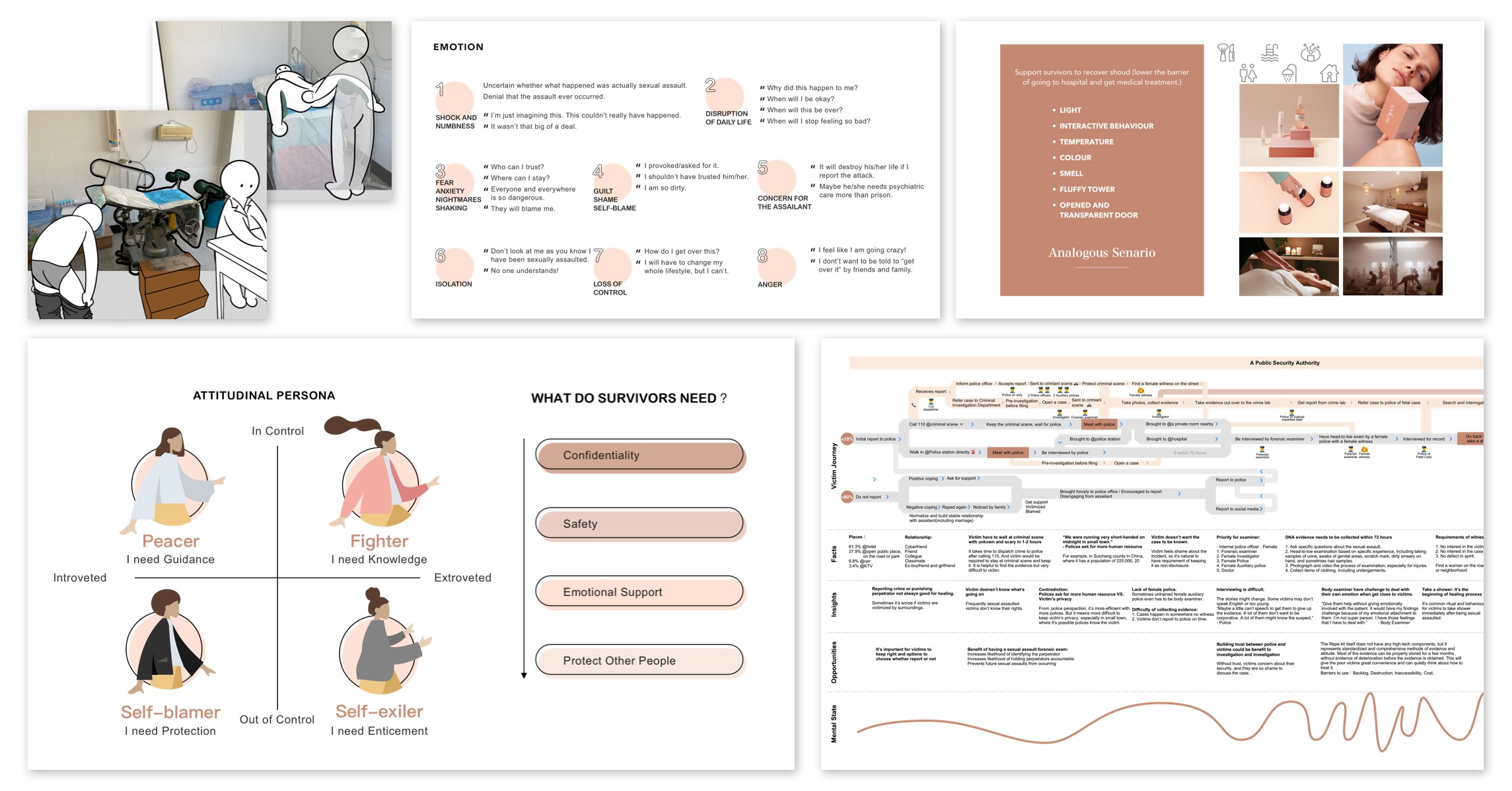
Every survivor’s journey varies. That is why it is vital that I respond to their particular needs, regardless of whether they reported the crime.
Core Needs
I need a close friend accompanying me , believing me and hearing me.
When I want to know what I don’t know, give me knowledge and tips with choice, rather than asking me what to do.
Following my interviews, I synthesised findings and were able to create an attitudinal persona which were presented and discussed with the stakeholders. These exercises formed a great foundation to move into feature ideation and prioritisation.
UX Challenges
1. What are the challenges or barriers with app use & adoption?
For this project, it was especially important that the service is as accessible as possible, which is why I work from a field research on the users daily routine to build on their existing moments.
2. How to classify the users in order to build moderate emotion engagement and provide information based on what they need?
One of the main considerations I took into account when creating the information architecture for this APP is the variety of users that will use it. The primary audiences are fresh survivors, who would be asking for help immediately. The secondary audience, healed survivors, come to the APP for information such as the sexual health tips, and speak their stories out confidentially. These two audiences use the APP for metal and physical health and safety.
3. How to build trust with different parties?
One of the many challenges of this project was to build the trust, including trust between the service provider and the user, new survivors and super-healed survivors, and the users in the community. Keep the confidentiality throughout the whole service.
4. How to make the knowledge more acceptable? Medium matters.
When the case happened, most of survivors denied it happened. But real story is a good way to teach knowledge and empathy on themselves, which is why the content should be presented through different mediums: audio and video stories, nearby survivors’ words on interactive maps and interactive stories written by super-healed survivors.
5. How to avoid abusing service?
Cyber bullying is quite common in the community, especially when it comes to sexuality. How to build a supportive community avoiding the risks of cyber bullying?
UX Solution
During the development phase, how to test the prototype was one of many challenges. So I settled up a lo-fi clickable prototype to aid the stakeholders conversations, rather than the users themselves.
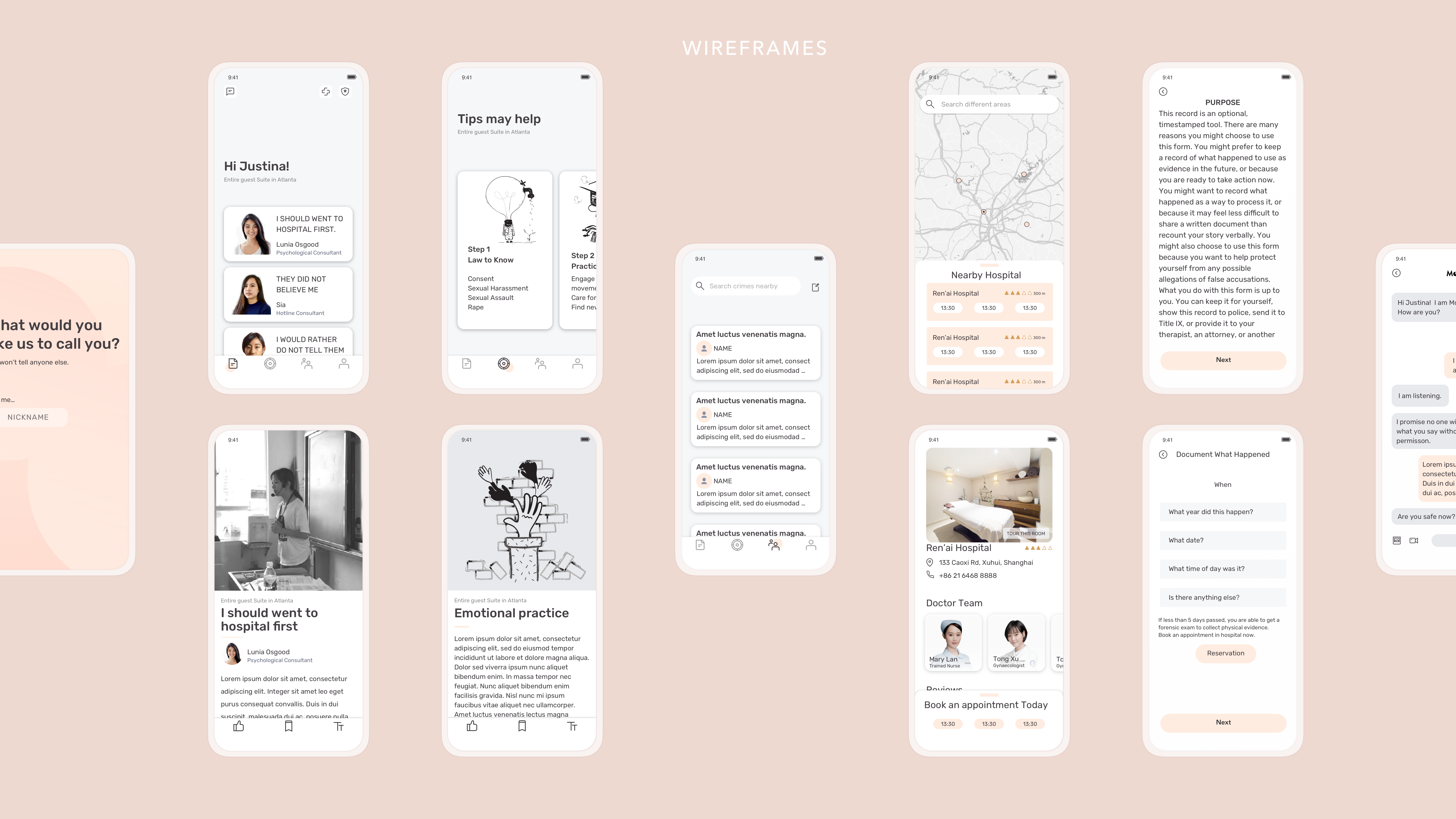
1. Create Demand
Build on existing moments: A man/woman sees advertising about iMPOWER in a beauty salon/ gym/ hotel / public bathroom, etc. Although he/she doesn’t need the service immediately, but he/she keeps it in mind and recommends it once his/her friends need.
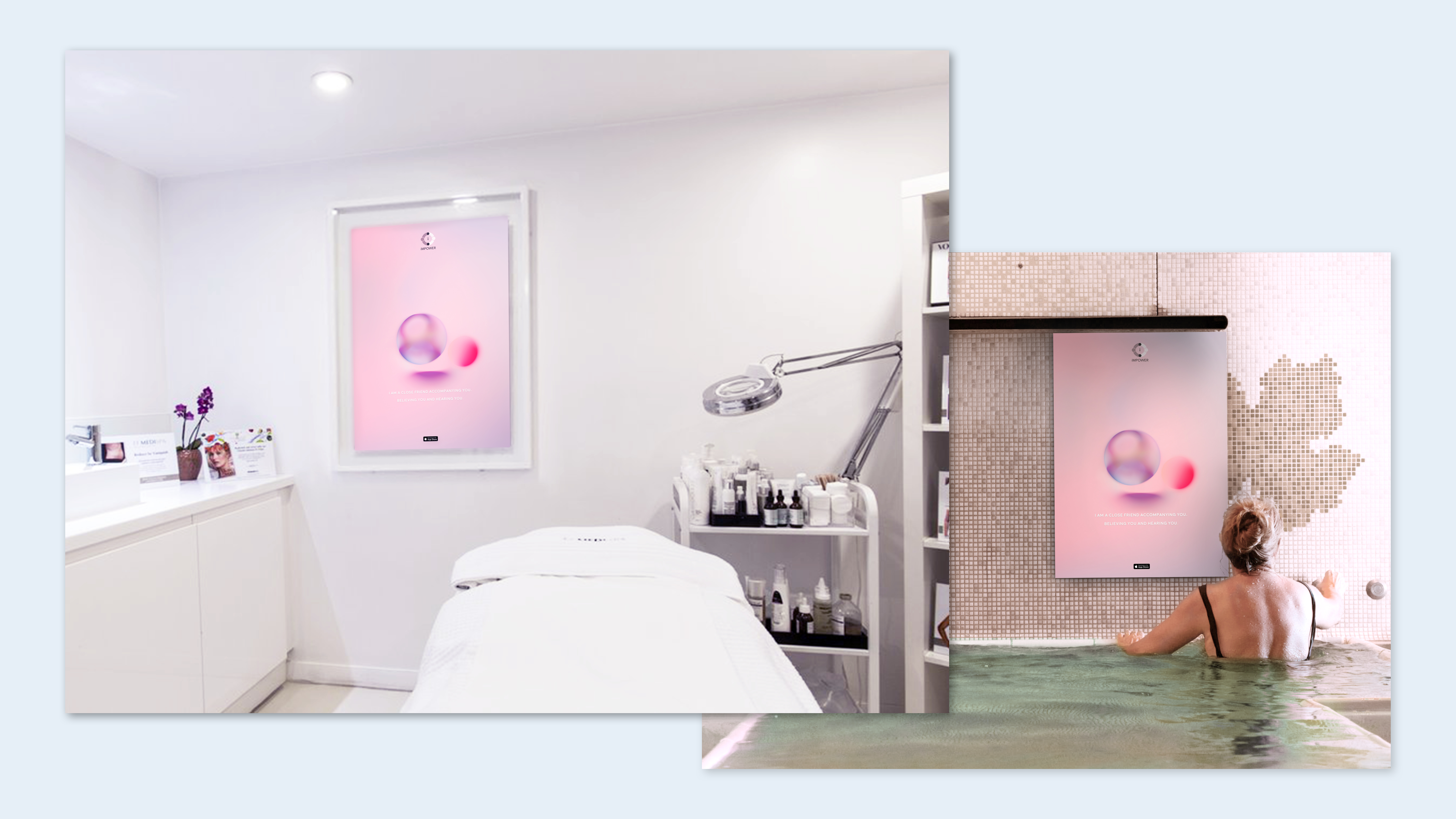
2. Account Creation
With the promise of protecting the confidentiality, I designed a short set of steps that can capture needed information, such as which stage they are at for providing timely and dynamic information. Instead of capturing the amount of data, asking less but precise questions made users feel more comfortable.
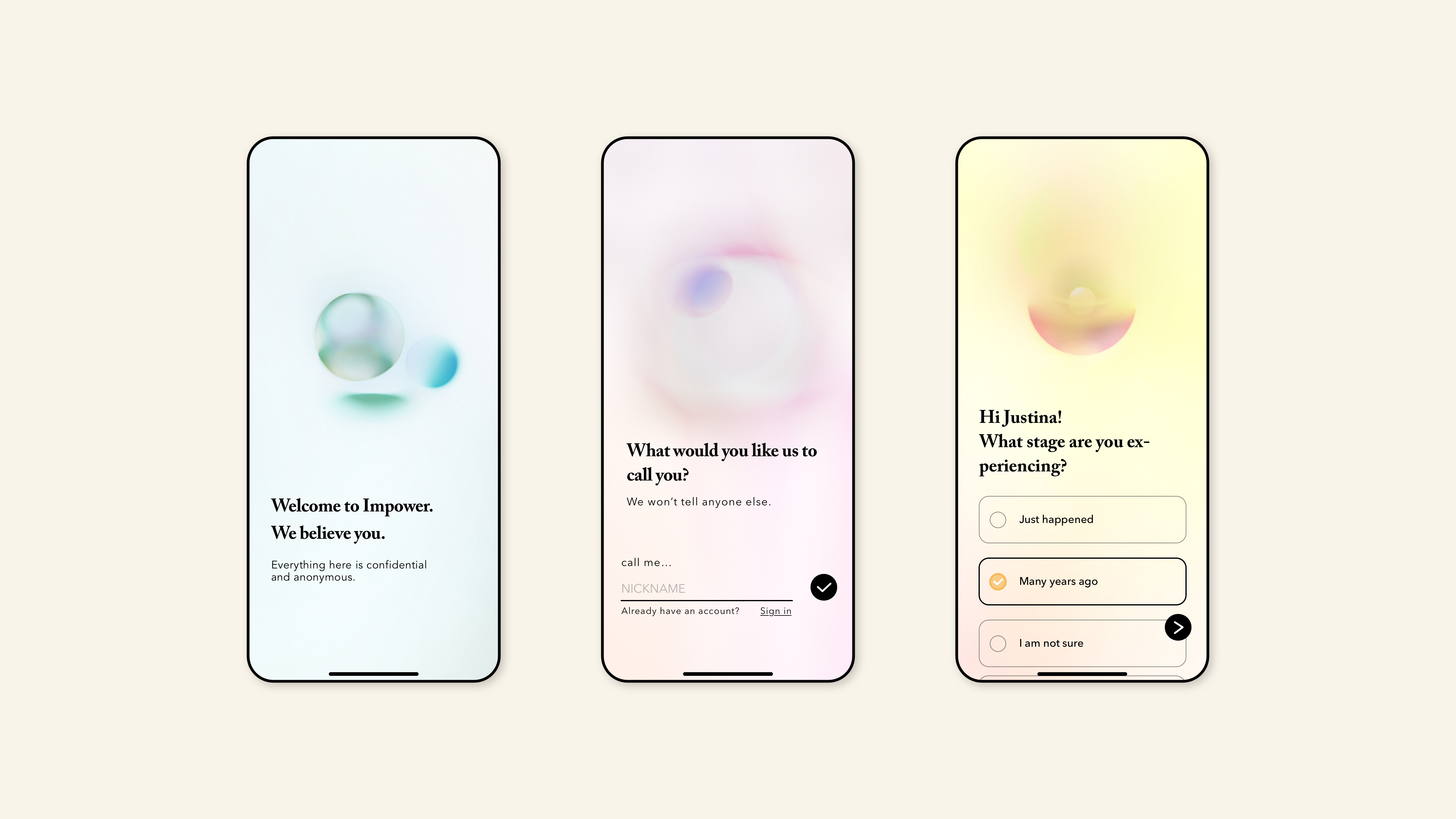
3. Interactive Light Map
Being new to the APP - safety and feeling supported was an essential part of a users initial and ongoing app experience. The map has three features: survivors around me, dangerous places near me and partner hospital searching. Behind the map, there was a community for survivors to tell their story and an appointment system for health checks and body examinations in the hospital. Each features are prioritised based on the stage the uses at.
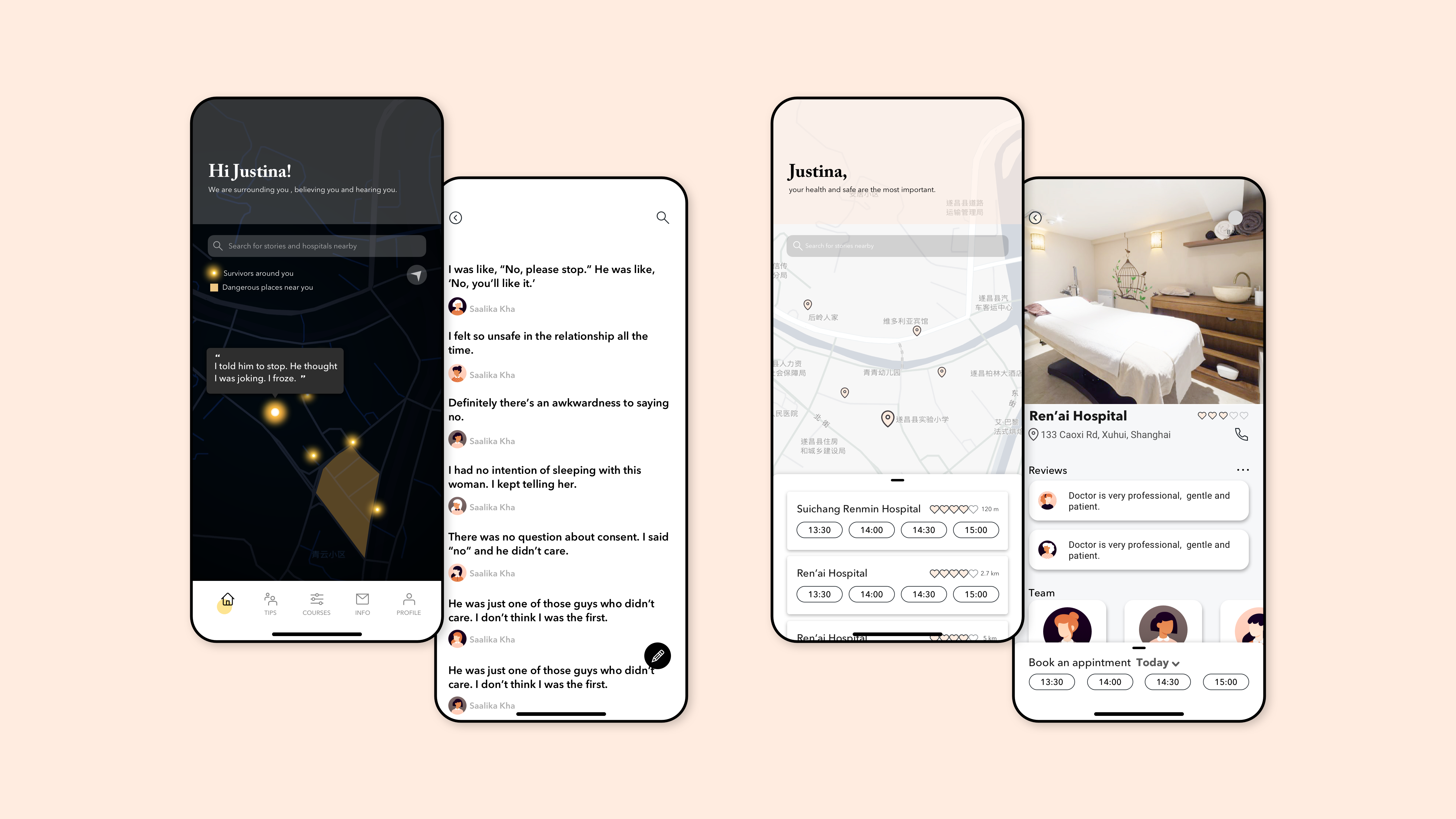
4. Instant Tip
In order to make the knowledge more acceptable and attractive, the instant tip was designed from a question came up when super-healed survivors experienced before. It was categorised by user’s stage. And the key answer to the question was highlighted above the story.
Based on the super-healed survivors real experience, the interactive story provide timely advice in particular sentences. User could understand what do to under the same circumstance, and ask for help with this super-healed volunteer.
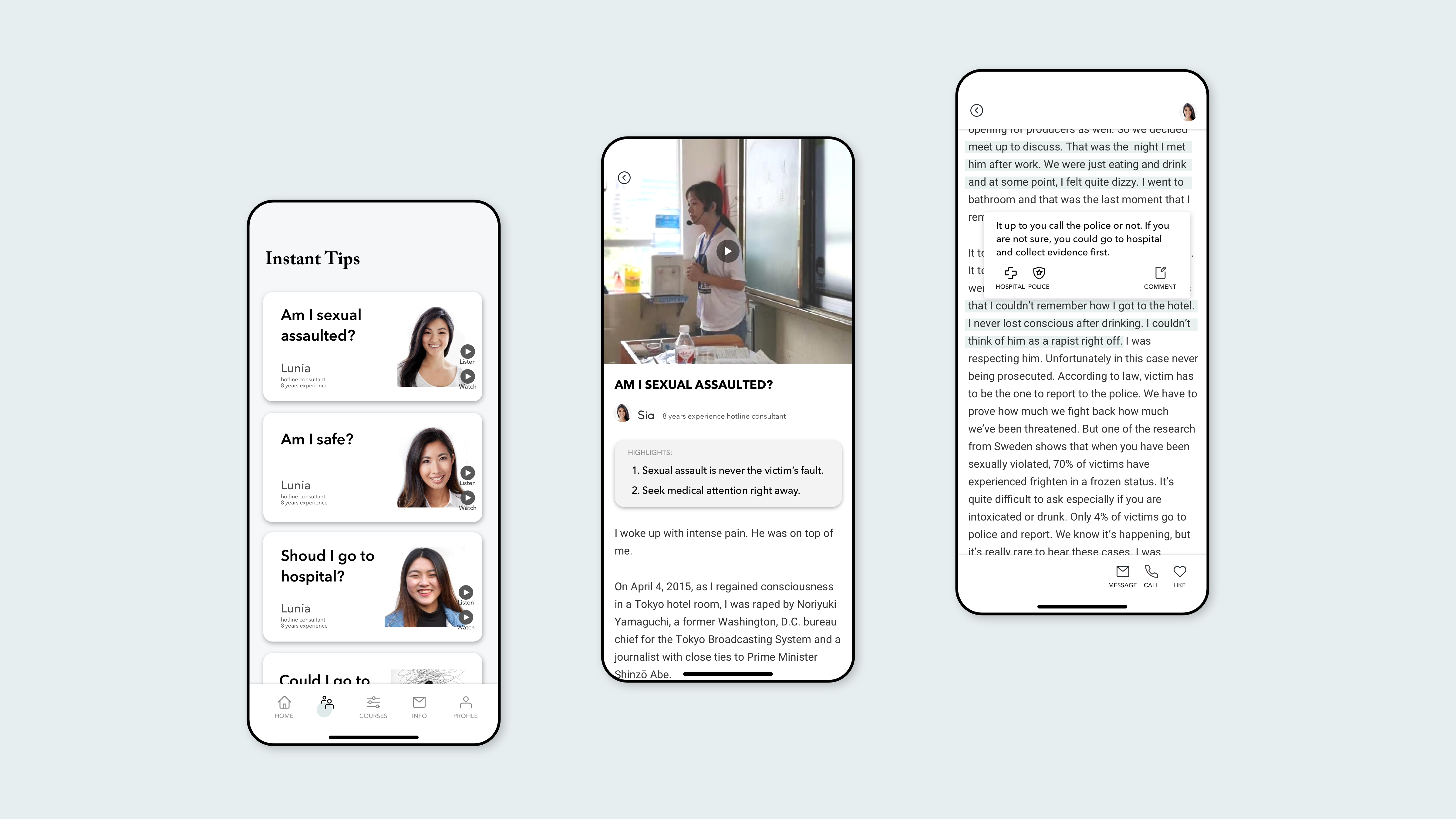
5. Courses
The courses including daily art, workouts, lessons (cognitive behavioural therapy for conquering PSTD symptoms), log (track daily symptoms activities and triggers) and quick relief (symptom oriented sessions)
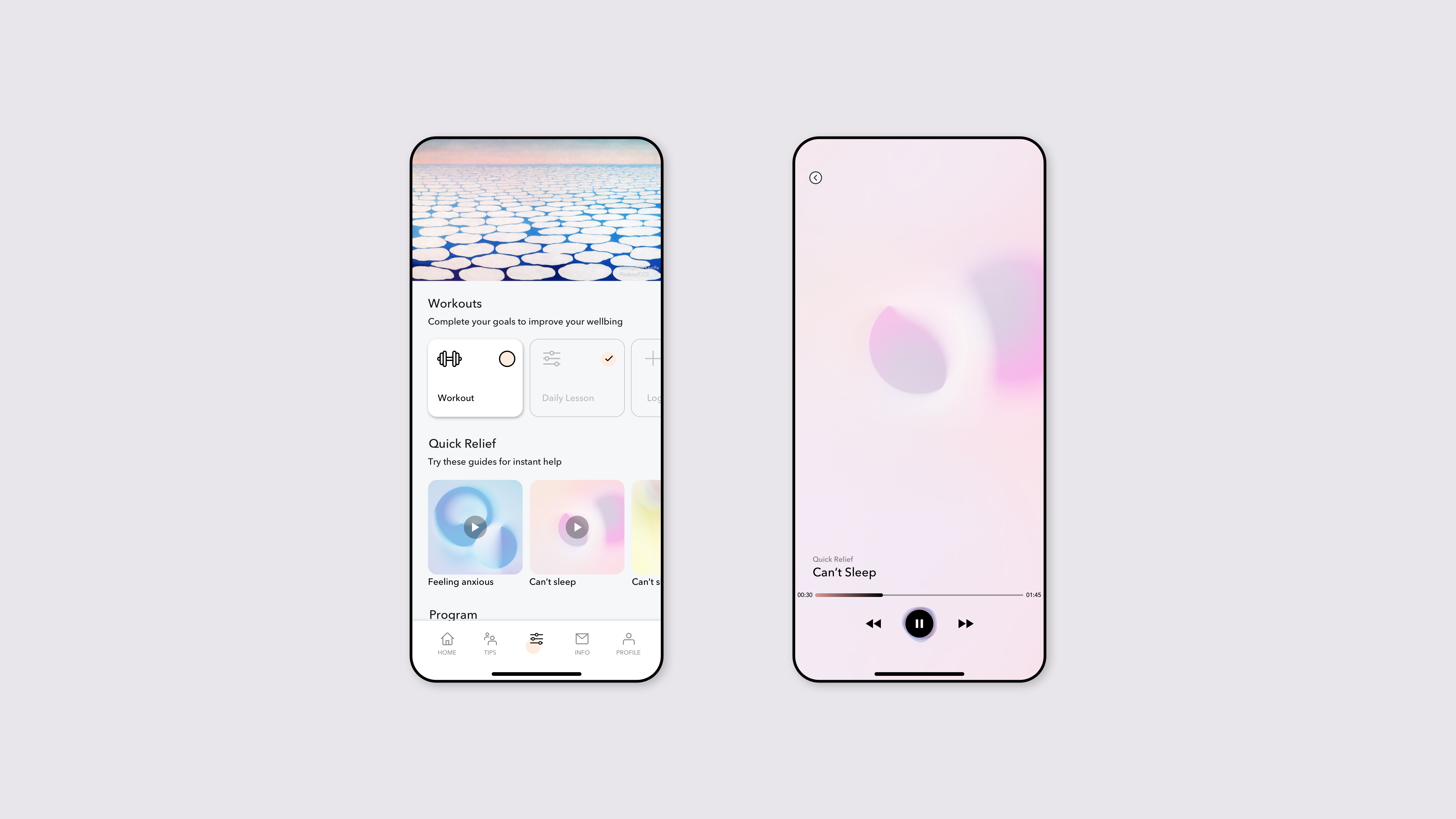
One More Thing
Because China doesn’t have the necessary infrastructure and service to handle sexual assault cases, especially in the hospital, I redesigned the medical treatment service for survivors.
What is the most difficult step for survivors during the medical treatment process? -BODY EXAMINATION
what happen if I move this tough moment out of the institution that I settled and conversely how would I change the institution itself ?

Product Solution(on-going)
After creating the appointment system for health checks and body examinations, I converted the body examination into a supportive and comfortable medical experience, and implemented an information transfer system to make patients aware of where they are in the medical process.
The main product is a health education book, which is redesigned body examination kit.

- A woman made an appointment online. Then she goes to the gynecology directly without registration.
- A nurse asks her: Would you like to collect evidence? She said yes, and nurse told her would going on with a health book.
- Test room is comfortable. She was covered by a fluffy tower. She feels relaxing when covering with familiar elements from the beauty salon.
- She tracks the kit and is informed timely through the APP and messages.
Infrastructural Change
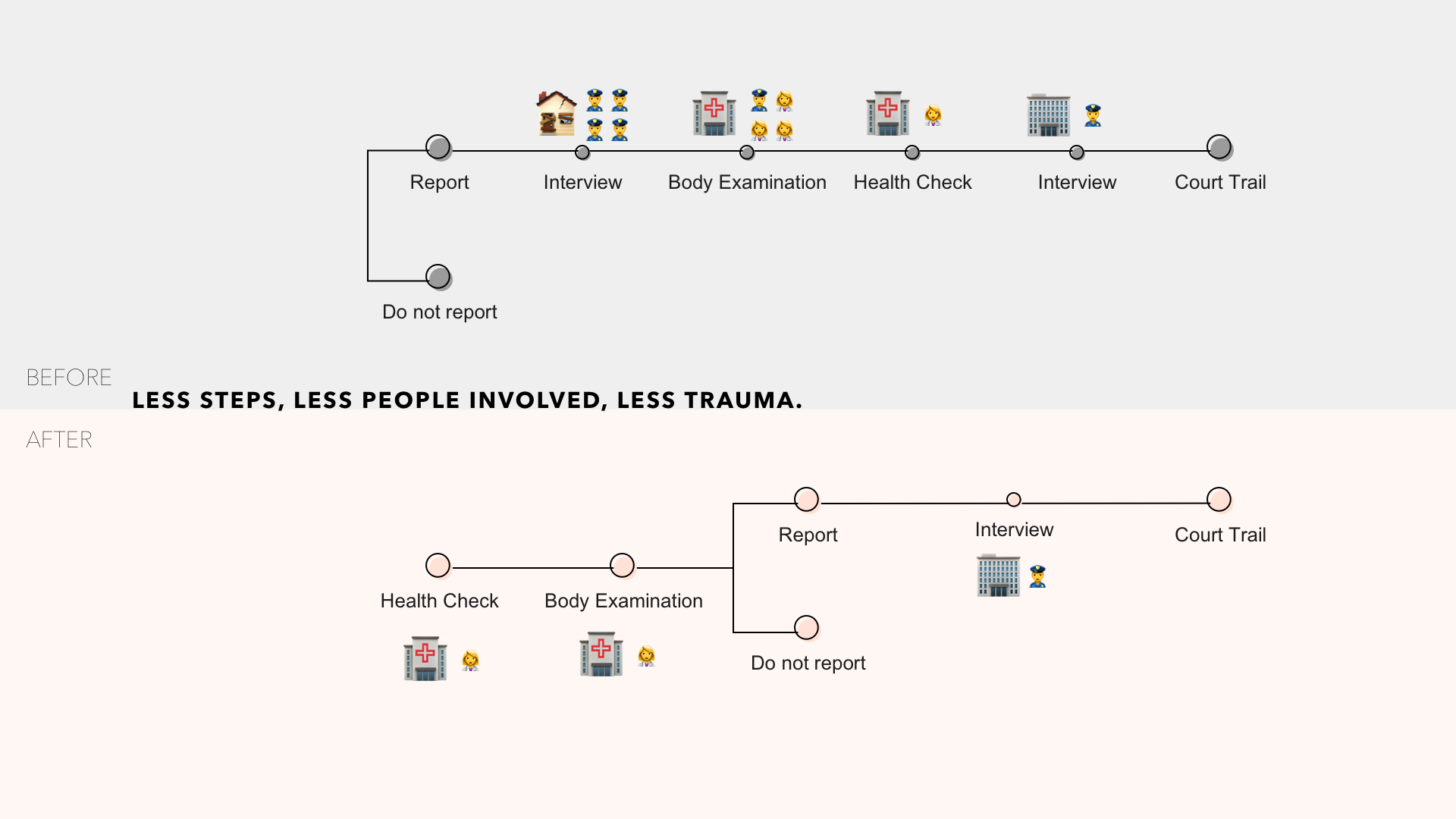
Learnings
1. How to minimise design in sensitive situation and broad the boundary of design?
It’s designer’s mission to work with multiple constraints. Throughout the design process, I’ve learned that empathy is the key to answer this question. Empathy on each stakeholders rather than regarding them just as stakeholders. Besides, changing tiny elements could have huge impact.
2. Avoid conformation bias
At first, my design question is: What can be instigated to protect survivors after sexual assault, rather than encouraging to report to the police? I tried to move the institution out of the hospital. I had conformation bias and brainstormed to put the body examination into public toilet and transfer it into self-service. Fortunately, after realising it, I re-evaluated design methods, and finally found insights to support assumption rather than let the research guide me.